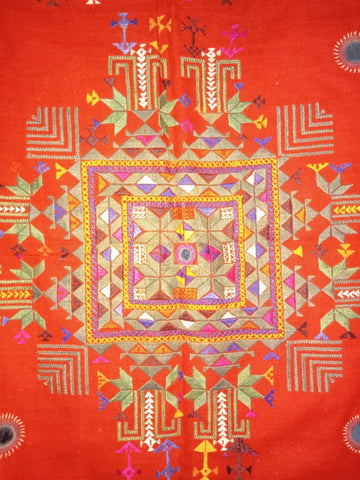Kashmiri Kashidakari
Kashidakari is the most famous embroidery of the Kashmir valley. The term ‘kashidakari’ literally means ‘needle work’. The origin of this craft is not clear but according to various legends it was introduced by Sufi saints from Persia in the valley. Numerous kings patronized the craft, the most famous of them being Sultan Zain-ul-Abidin. Over the course of time it started to define the cultural essence through the intricate interplay of beadwork, threadwork, and the region's distinctive motifs, creating a timeless symbol of Kashmiri artistry and tradition.
The term Kashidakari is used as an umbrella term which covers all the different types of embroideries. Hence it uses many different embroidery techniques such as crewel or ari work, rezkar, tilla, sozni and dori work. Sozni embroider uses fly stitch, stem stitch and darning stitches. The ari embroidery uses aari to fill in the motifs with chain stitch. It uses stitches such as chain stitches or zalakdodozi, open work or doria work, buttonhole stitch or vatachik and gold work or talibar. The embroidery is used for phirans or the woolen kurtas and namdahs or the woolen rugs and stoles.

Motifs
The motifs are inspired from their geographical surroundings and what the artists saw around them. They are inspired from the birds such as parrots, woodpeckers and kingfishers; the floral motifs are inspired from lotus, lily, saffron flower, iris and tulips. The other designs include grapes, plums, almonds and cherries. An important motif in the Kashmir region is the chinar leaf.
With the coming of Islam in the valley, the embroidery style amalgamated within it the Persian motifs and design. This led to the evolution of the Indo-Persian floral pattern in Kashidakari. It continued to evolve under the shifting patronage of the different rulers of the valley such as the Afghans, Dogras and the Sikhs.

Characteristic features
- The embroidery is practiced mostly by men.
- It is done using a single thread on fabrics such as silk, wool or cotton using thick threads.
- The colours used are safed (white), zingari (green), uda (purple), firozi (blue) and gulnar (crimson).
- A completed Kashidakari looks exactly the same on both the sides of the cloth, and can be worn from either side.
Rajasthani Kashidakari
Kashidakari in the state of Rajasthan developed with the influx of migrants in the backdrop of the 1971 Indo-Pak war. Hundreds of migrants who settled in the region practiced the kashida embroidery as a tradition. The origin of this craft is not clear, but it was started as a way of upcycling the clothes by giving them a new look.
There are two different types of Kashidakari done in the region – Soofi kashida and Sindhi Kashida. Although both of the embroidery forms are practiced in the region, soofi kashidakari is more common in Pakistan while Sindhi kashidakari is more famous on the Indian side of the border. It is practiced by many communities in the state of Rajasthan. The two major communities which practice this craft form are the Meghwals and the Jats.
The different types of Kashidakari given as part of the dowry among others are gochna or an embroidered square used to wrap rotis; batua or rectangular pouch which is filled with wheat during the wedding as a symbol of prosperity; panga or an embroidered fan for the bridegroom; takia or a ring kept on the head to place the earthen pots.

Motifs
The motifs are inspired from what the women see around them and is further beautified by their imagination. They embroider trees, plants, birds and animals such as peacocks, parrots etc. using bright colours and geometric shapes. The socio-political changes in the region led to a constant evolution of the motifs which came to include the geometric patterns and bold designs from the Persian art and craft. The motifs also derive inspiration from the architectural structures of the region in the form of jali work.

Characteristic features
- The embroidery is practiced by women.
- Kashida embroidered clothes are given as dowry to the bridegroom’s family.
- The embroidery is a way of sustainable living and practices embroidery to upcycle the worn out clothes. Although today it is mostly done on fresh cloth for commercial purposes.
- There is an excessive use of mirrors as there is a common belief that they repel evil eye.
Written by ~ Misha Jaswal























